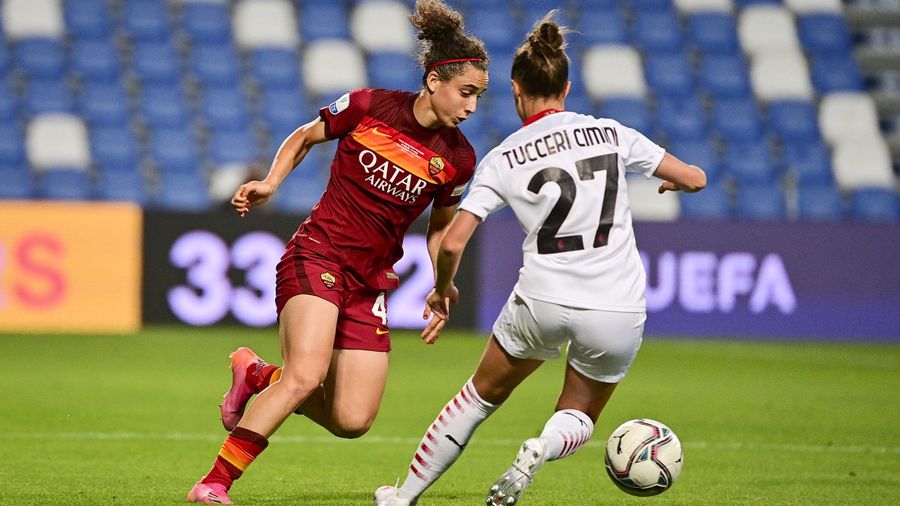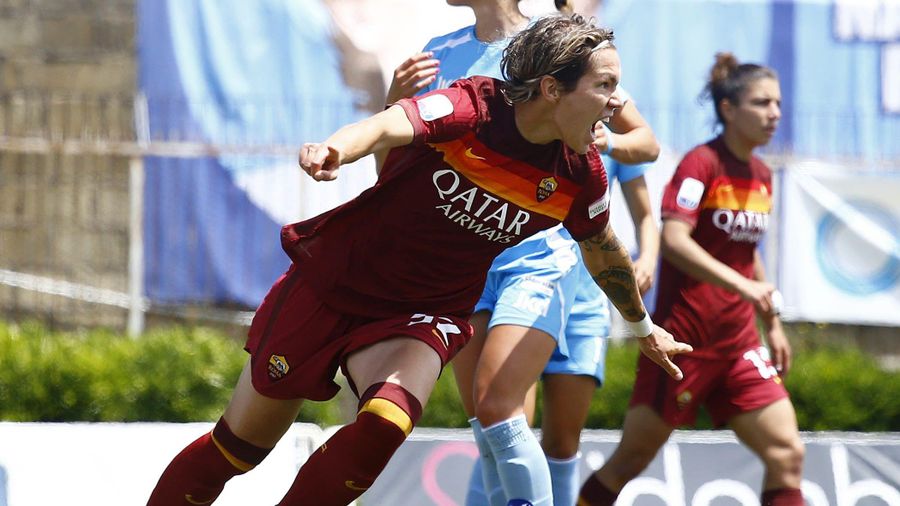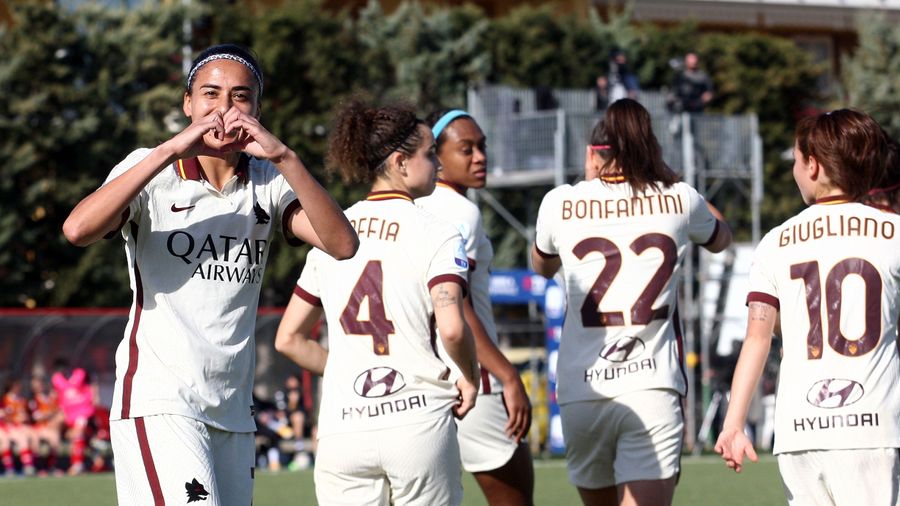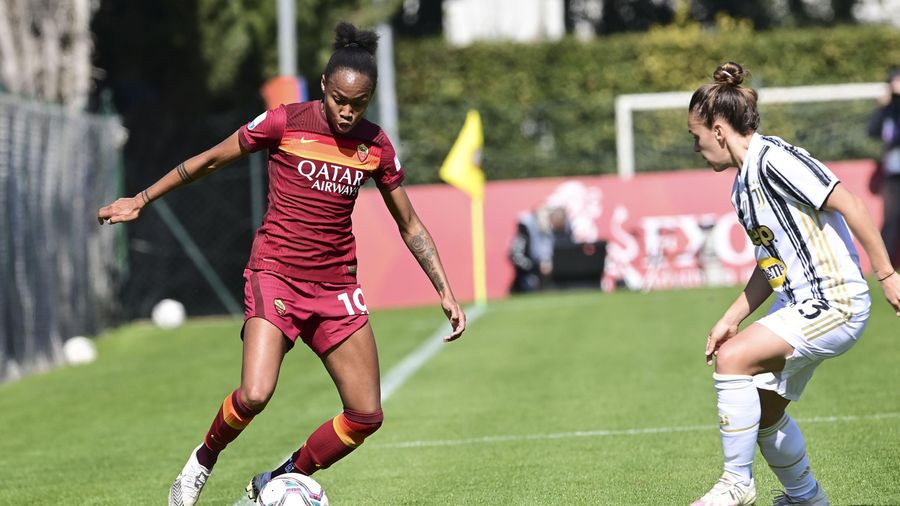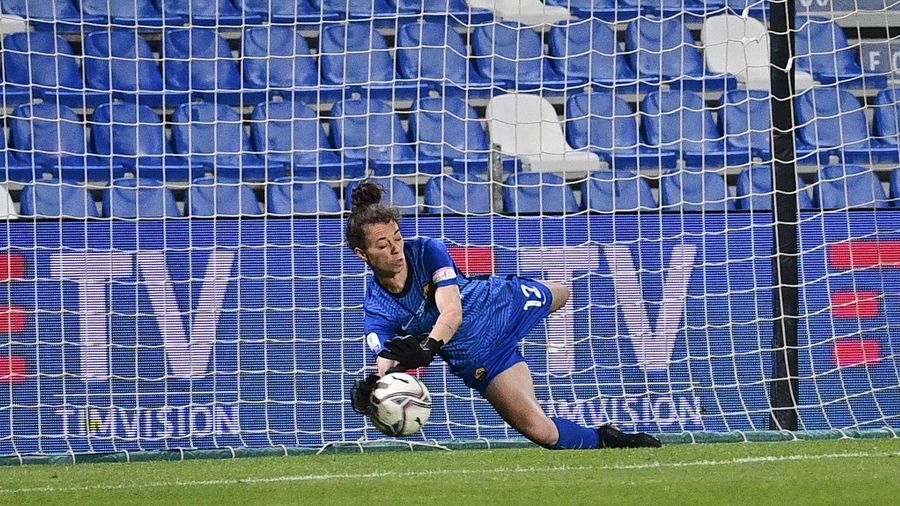

In their third season since their formation, Roma Women proved their progress by winning their first ever trophy, the Coppa Italia, while securing a fifth-place finish in Serie A.
Resuming action for the first time in half a year when the campaign began, what followed required an intense effort from all members of the squad.
Their work paid off as they claimed a first honour, a landmark achievement after three years of working to improve.
To reach such a target, they required some key players to step up more than ever before. Once they had achieved their ambition, those players could enjoy the recognition their efforts deserved.
For some, like captain Elisa Bartoli and all-time top scorer Annamaria Serturini, their influence on the team goes without saying.
Adding to the solid foundations they provide, here, we have picked out seven individuals who helped the team in different ways across the whole course of the campaign.
The Player Who Started The Season Strongest
After joining Roma from Fiorentina in the summer of 2020, Paloma Lazaro could not have made much of a better first impression.
The Spanish striker slotted straight into the starting line-up, instantly making her presence known with goals in each of her first two games. It was the springboard she needed to launch her Roma career.
In total, of the 11 goals Lazaro managed in her debut Roma season, more than half came within the first seven matchdays. During that time, she scored a wide variety of goals, with her range of headers, one-on-one finishes and a cushioned volley showing the technique of someone capable of being a complete striker.
Acting as a focal point to Roma’s attack, Lazaro often impressed with her positional sense and composure in front of goal.
Her scoring rate slowed down in the later weeks of the season, but she still appeared with the occasional important goal, such as her header in the second leg of the Coppa Italia semi-final against Juventus, which effectively took the tie beyond the opponents’ reach.
All strikers go through differing spells of form, but can rely on their instincts to serve them well whenever. Lazaro remained important throughout the season, but those first few weeks were certainly the most exciting.
The Player Who Finished The Season Strongest
The Roma Women project has been built upon a process of giving young players the platform to develop, in the hope that the club’s faith will be rewarded as they gain more experience and begin to flourish a few years down the line.
No player epitomises that more than Angelica Soffia, who arrived at Roma upon their foundation as a teenager still maturing into a full-back role and finished her third season in the capital as one of their most reliable players.
Still just 20 years old during the 2020-21 season, Soffia regained her place higher up the hierarchy after seeing her opportunities fade slightly the previous year due to the arrival of Kaja Erzen.
When her Slovenian teammate had to take some time out of the team, or on the rare occasions Bartoli was missing on the other side of the defence, Soffia took her chances. Her commitment and willingness to put herself to use wherever the team needed, not shying away from the challenge, reflected why she was ready to contribute more again.
Soffia’s levels soared in the final few months of the season. Ever dependable, she grew more confident in one-on-one-duels with opponents and provided an attacking threat when she supported those further up the field.
Able to skip past opponents with ease when on the ball and to frustrate them in equal measure when trying to win possession back, Soffia began to dominate her side of the pitch.
The deserved reward came in April 2021, when she made her senior international debut for Italy. Having already added to that maiden cap and scored twice for her country, she will be looking to continue building her burgeoning career.
Player Who Improved Those Around Them
There was a clear demarcation point between Roma being a promising but somewhat inconsistent team, to becoming a dominant force that would eventually be able to successfully challenge for titles.
It was the January arrival of Elena Linari that made most of the difference.
Ardent followers of women’s football in Italy needed no introduction to the player, who had already amassed more than 60 caps for her country, won league titles with three different clubs, and still had plenty of prime years ahead of her.
After a brief spell in France with Bordeaux, Linari’s return to Italy with Roma benefited both player and club to a huge degree. The centre-back effectively took the place of Tecla Pettenuzzo – who at 21 years of age was doing relatively well but still has plenty of experience to build up – and formed a solid partnership with Allyson Swaby.
Not only did Linari hit the ground running, but Swaby’s performances also showed signs of development, at a steeper rate than ever since her November 2018 entry into Italian football.
Between them, the pair protected the Roma goal at all costs, with Linari the leader but Swaby also strong.
Sometimes, the addition of just one player can transform a team, which is exactly what happened with Linari. Inspirational on and off the pitch, she took a key role and commanded respect from all those around her, who raised their own levels as a result.
Player Whose Purple Patch Set Roma On Their Way To Success
Linari’s arrival was not the only stimulus that improved Roma’s form in the New Year. While the Italian was holding down the defence, Brazilian playmaker Andressa Alves was enjoying the best goalscoring run ever produced by a Roma Women player.
A hat-trick against Roma CF in the second Coppa Italia group match, including two free kicks either side of a tap-in, was just the beginning for Andressa. It was the first of six consecutive games in which she scored at least once.
She proceeded to score a penalty against Napoli, a reactionary first-time strike against Sassuolo and goals in both legs of the Coppa Italia quarter-final against Florentia, bookending a spot kick against Pink Bari in the league.
Roma won all six of those matches, which gave them a solid platform from which to accelerate their pursuit of glory in the remaining weeks of the season.
After their results regularly drifted between wins, draws and losses in the first part of the campaign, Roma finally had some positive consistency – and Andressa’s influence was a major contributing factor.
That spell of form was the best yet of her two seasons in the capital, which will extend into a third year in 2021-22. Over that time, Andressa has developed her role, with Betty Bavagnoli utilising her blend of creative and combative qualities in a central area in behind the striker, rather than the wider position she arrived in, to great effect.
Not only developing technically as a result, she has also become one of the team’s biggest leaders. Her dominant spell between January and February lifted the team to new levels, showing why she is such a reference point for the squad.
Player Who Stepped Up Most When Needed
It was not all an easy journey for Roma in 2020-21, especially when the team lost two of their most important options in midfield.
Giada Greggi, one of the Roman members of the squad who has shown maturity beyond her years to become one of the vice-captains, and Andrine Hegerberg, one of the most experienced midfielders at the club who possesses traits that are relatively unique in this group of players, both suffered ACL injuries to rule them out for a number of months.
Roma had to adapt in their absences, finding different solutions in midfield. Manuela Giugliano sometimes altered her role and Vanessa Bernauer continued to be consistent, but the player whose impact increased by the largest margin compared to the prior season was Claudia Ciccotti.
A member of the founding Roma Women squad from 2018, Ciccotti had featured less frequently in 2019-20, partly due to injury issues of her own. Despite remaining a core leader, there may not have been as many expectations on her going into the 2020-21 season.
But she regained her best form and put together a string of consistent performances when she was needed most, multiplying her number of Serie A starts from the previous year fivefold.
Providing balance to the midfield with her ability to move between the lines and awareness in the defensive phase, the Rome-born player ensured her side did not suffer when deprived of two important components.
Player Who Developed Their Role The Most
After scoring an impressive nine goals in her first season for Roma, few would have predicted that it would take Lindsey Thomas until February to get off the mark in the follow-up campaign.
Yet the fact that her performance levels were still largely positive in the time until then showed how she was adapting and developing.
Often featuring as a centre-forward in 2019-20, but capable of moving to the wing, she rarely left the latter territory in 2020-21. The arrival of Lazaro up front left Thomas needing to alter her game to maintain her place in the side, while competing with Agnese Bonfantini for a starting berth.
Thomas went about the task in an exemplary manner, establishing herself as the more regular starter and becoming an integral part of how Roma’s attack functioned, even if she was not scoring as many goals herself anymore.
Thomas made more assists than any of her teammates in Serie A, providing danger with her crossing and dribbling ability. Still a threat despite the decrease in goals, she selflessly stepped aside for others to take the spotlight, but still put in several important performances that may have gone somewhat under the radar.
She saved her best for the Coppa Italia, scoring in both legs of the semi-final against Juventus at critical times to provide proof that her instincts were still there.
But even in the league, she was one of only three players – along with Swaby and Serturini – to play in all 22 games, showing how important she was still deemed to be by Bavagnoli.
Player Whose Performance Earned Roma Silverware
Roma’s ascension to becoming Coppa Italia winners was a team effort, but if there was one player who really went above and beyond to ensure their triumph in the final, it was Camelia Ceasar.
The Romanian goalkeeper has always been reliable since joining the club from Milan in 2019, but saved her best performance for when it mattered most.
Ceasar commanded her area brilliantly in the final against her former side, making a number of decisive saves across the two hours that led up to the penalty shootout. Always alert, she averted any danger that came her way by parrying the ball into safer territory or keeping hold of it.
It had been a very close game, with both sides defending well, and it was fitting that after extra time, Ceasar’s clean sheet was still intact.
If her performance in open play was impressive enough in itself, then her contribution in the penalty shootout was even more so. By saving Milan’s first penalty, Ceasar eased the tension her teammates may have been feeling and gave them the impetus.
The opponents kept things alive by scoring their second spot kick, but Ceasar was equal once again to their third, making another vital save that rose the anticipation levels even further.
By this point, Giugliano and Serturini had already scored their penalties to put Roma in the ascendancy, and even though Linari missed hers, her side remained in the driving seat when Milan failed to convert their fourth attempt. This time, the shot hit the post towards which Ceasar was diving, so even if the effort had been on target, she would likely have had a third shootout save to her name.
Penalty shootouts are a test of endurance, mentality and ability for a goalkeeper, and having done her preparation, Ceasar ticked all three boxes to ensure that when Bernauer scored the next effort, it was the winner.
Thus, Roma Women got their hands on their first ever trophy to cap off another season of progress, in which many players played a significant part.







 Shop
Shop


















